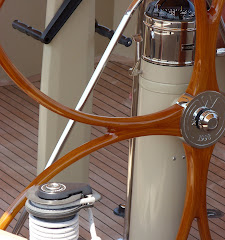 The transom was cut at the same time as the hull parts and has been laying around in the boat, under the boat on a shelf, you get the idea. When the time came to install it we found that a few twist and bends had found there way in. In order to get it straight for installing we simply screwed it to a 3” x ¾” piece of plywood to hold it flat. As you can see from the photos we then clamped it in place aligning the center with the hull center. There was a gap at each side of ¼”, a little larger on the port side. Using a strap we were able to bring both side panels up and in so that the gaps were filled. Then a few fillets and it was in place.
The transom was cut at the same time as the hull parts and has been laying around in the boat, under the boat on a shelf, you get the idea. When the time came to install it we found that a few twist and bends had found there way in. In order to get it straight for installing we simply screwed it to a 3” x ¾” piece of plywood to hold it flat. As you can see from the photos we then clamped it in place aligning the center with the hull center. There was a gap at each side of ¼”, a little larger on the port side. Using a strap we were able to bring both side panels up and in so that the gaps were filled. Then a few fillets and it was in place. We prepped the hull one last time for installing the transom and sole by coating all the area under the line of the sole with two coats of epoxy and filling any leftover holes from temporary screws. We had decide not to paint this area as it is for the most part never to be seen again.
We prepped the hull one last time for installing the transom and sole by coating all the area under the line of the sole with two coats of epoxy and filling any leftover holes from temporary screws. We had decide not to paint this area as it is for the most part never to be seen again.All the sole pieces are in except the aft both sides. This allows us to tape the transom in with two layers of biaxial 12 oz tape first. The plans show the sole installed in 3 pieces each side, however it is impossible to install the mid-section this way. It simply will not go in because the opening in frame “C” is to small. We made a seam at frame “C” and solved the problem. The only effect for adjusting this on the plans might be in nesting and saving a small amount of plywood but without running a nesting solution program it’s hard to say.
There are a lot of fillets to get finished and then a lot of taping around the hull to sole joints before anything else will take place.
Time this segment:
2 Coats of epoxy below sole line 1 hour
Fill any remaining holes below the sole line ½ hour
Install and fillet Transom:1 hour
Install Forward and mid-section soles 1 ½ hours
Total Project: 107 hours

 In order to make the sole installation as easy as possible we decide to first cut a template using corrugated cardboard. We purchased 4 sheets 4’ x 8’ from a local packaging supply company. This would prove much less expensive to make an error on than the plywood.
In order to make the sole installation as easy as possible we decide to first cut a template using corrugated cardboard. We purchased 4 sheets 4’ x 8’ from a local packaging supply company. This would prove much less expensive to make an error on than the plywood.












